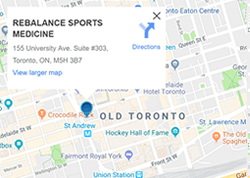The Hamstrings and Low Back Pain
 The hamstrings are a one of the most important muscle groups of the body and are often overlooked when it comes to training, stretching and lower back pain. The hamstrings are made up of three distinct muscles; bicep femoris, semitendinosus and semimembranosus. In general, the hamstrings originate from the tibia and fibula (lower leg bones) and insert into the ischial tuberosity (bottom of pelvis) and the femur (thigh bone). In terms of function, the hamstrings allow the hip to extend (backwards) and they allow for knee flexion (knee bending). While your hamstrings contribute to functional motions, such as walking and running, they also help you to achieve speed, power and agility in many sports.
The hamstrings are a one of the most important muscle groups of the body and are often overlooked when it comes to training, stretching and lower back pain. The hamstrings are made up of three distinct muscles; bicep femoris, semitendinosus and semimembranosus. In general, the hamstrings originate from the tibia and fibula (lower leg bones) and insert into the ischial tuberosity (bottom of pelvis) and the femur (thigh bone). In terms of function, the hamstrings allow the hip to extend (backwards) and they allow for knee flexion (knee bending). While your hamstrings contribute to functional motions, such as walking and running, they also help you to achieve speed, power and agility in many sports.
Many of our clients have desk job which mean long hours of sitting. With prolonged sitting, the risk of poor postures comes into play. A very common postural dysfunction from prolonged desk work involves rounding in the low back and weight shifting towards the back of your sit bones. In this position, the hamstrings are shortened and become tighter. Short and tight hamstrings ultimately pull the pelvis downward and cause flattening of the low back curvature. This can lead to additional pressure on the sacroiliac joints (SIJ), as well as increased strain on the lower back muscles, ligaments, discs and facet joints. Over time, after sitting this way for months and years, the body will no longer be able to handle the added strain and pressure to this region and pain will develop.
If you sit a lot and especially if you sit in poor postures, it can be important to stretch your hamstrings regularly to keep them flexible. Hamstring stretching can help to prevent the onset of low back pain and even help to resolve low back pain in some individuals. It is very simple to do. Here are a few examples of hamstring stretches you can do at home.
Example 1:
 While lying on your back keep one leg flat on the ground and lift the other straight in the air while holding the back of your thigh for leverage. Try to actively straighten the leg in the air until you feel a gentle stretch. Don’t hold your breath. Hold this stretch for 30 seconds to 1 min and repeat as needed.
While lying on your back keep one leg flat on the ground and lift the other straight in the air while holding the back of your thigh for leverage. Try to actively straighten the leg in the air until you feel a gentle stretch. Don’t hold your breath. Hold this stretch for 30 seconds to 1 min and repeat as needed.
Example 2:
 Kneel on one knee with the other leg in front of you. Place your hands on the floor to support yourself. Straighten the front leg slowly until a gentle stretch in your hamstring is felt. Be sure to keep the front foot flat on the ground. Hold for a count of 10 seconds and then bend to release and repeat as needed. You may repeat the stretch with the foot turned out, and then with the foot turned in to get all the bands of your hamstring muscle group.
Kneel on one knee with the other leg in front of you. Place your hands on the floor to support yourself. Straighten the front leg slowly until a gentle stretch in your hamstring is felt. Be sure to keep the front foot flat on the ground. Hold for a count of 10 seconds and then bend to release and repeat as needed. You may repeat the stretch with the foot turned out, and then with the foot turned in to get all the bands of your hamstring muscle group.
Example 3:
 Sit up tall in a chair and place your foot on a stool. Place your hands on your knees and bend forward from the hip until you feel a gentle stretch in the back of your leg. The toes of the stretched leg should not be pointing forward but lifted up. Try to keep your leg as straight as possible while doing this stretch. Hold for 30 seconds to 1 minute and repeat as needed.
Sit up tall in a chair and place your foot on a stool. Place your hands on your knees and bend forward from the hip until you feel a gentle stretch in the back of your leg. The toes of the stretched leg should not be pointing forward but lifted up. Try to keep your leg as straight as possible while doing this stretch. Hold for 30 seconds to 1 minute and repeat as needed.
The team at Rebalance Sports Medicine promotes prevention of injuries by keeping your body both strong and flexible. If you feel tight in your hamstrings be sure to give these simple stretches a go. If you are already experiencing low back pain or related symptoms, be sure to visit an a trusted health professional (physiotherapist, registered massage therapist or chiropractor) who will help to diagnose the root of your problem and set you up with a plan that is sure to get you feeling better in no time. Our team in downtown Toronto loves helping patients recover from all sorts of injuries including low back pain so check out our team page and then contact us to book your initial consultation.
Written By: Giuliano Calleri, RMT
Rebalance Toronto
Rebalance Sports Medicine is a multidisciplinary clinic in downtown Toronto offering physiotherapy, chiropractic, registered massage therapy, sports medicine, naturopathy, Pilates and more.



 What to Expect From Your First Physiotherapy Visit
What to Expect From Your First Physiotherapy Visit The Benefits of Fascial Stretch Therapy [Demo]
The Benefits of Fascial Stretch Therapy [Demo] How Does Physiotherapy Work?
How Does Physiotherapy Work? Best Exercises for Low Back Pain
Best Exercises for Low Back Pain